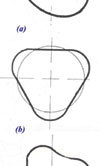Aluminium matrix composites
 Although cast iron cylinder liners have always been a safe and reliable choice, the differential expansion rate between them and the aluminium pistons, as well as their shear weight, has always encouraged designers to look for better alternatives. When cylinder blocks were cast iron, engines were so heavy as to make any change in the cylinder liner material utterly futile but as demands for lighter engines made aluminium more attractive, the push towards some kind of aluminium cylinder liner was only to be expected.
Although cast iron cylinder liners have always been a safe and reliable choice, the differential expansion rate between them and the aluminium pistons, as well as their shear weight, has always encouraged designers to look for better alternatives. When cylinder blocks were cast iron, engines were so heavy as to make any change in the cylinder liner material utterly futile but as demands for lighter engines made aluminium more attractive, the push towards some kind of aluminium cylinder liner was only to be expected.
Aluminium-silicon alloy materials are some of the most widely used for castings of all types. At silicon levels of less than 11.7% (the eutectic point) these hypoeutectic alloys are characterised by excellent fluidity during casting and impressive corrosion resistance as well as being readily machined. Specifications like LM4 ( 5%Si) and LM25 (7% Si) have been common place in the past as cylinder block materials, but when used uncoated as a cylinder liner, they are totally unsuited.
In the mid 1960s, this issue of iron or steel piston rings running against the parent metal bores in aluminium cylinder blocks was partially solved by the introduction of a thin layer of silicon carbide material. Deposited electrolytically, these processes were expensive and were not always robust when viewed against the demands of the engine OE business. Increasing the amount of silicon beyond this eutectic point to somewhere between 15-25% and producing what are now known as hypereutectic alloys, improves the wear characteristics and also reduces thermal expansion but all this is at the expense of machinability which together with the spray compacting technique used during manufacture, make them very expensive.
A different approach and altogether considered to be much cheaper, is the use of metal matrix composites particularly those using a particulate ceramic such as silicon carbide or in the example below, alumina (Al2O3).
Consisting of a metal phase and a ceramic phase, which are not miscible, MMCs in cylinder liners can be designed to have wear resistance similar to that of the cast iron that they replace. However the major issue with aluminium MMCs is ensuring that the ceramic element is in the optimum position within the liner and isn’t all cramped up in one particular place in the component where it’s properties are of little value. The favoured method of manufacturing top quality liners is casting, and like high quality cast iron liners, these can be made using centrifugal casting techniques.
A continuous process and hence much favoured by production engineers, centrifugal casting rotates the heated cylindrical mould while at the same time introducing the molten mix. The centrifugal force generated from the revolving mould forces the molten mass against the wall of the mould, which quickly cools and solidifies. Any low melting point impurities as well as gases that would otherwise cause porosity will quickly migrate to the centre leaving a high quality fine grain structured material at towards the outside of the cylinder with the lower quality, impure metal left towards the centre. Once cooled the poor quality metal in the centre can be machined out leaving a high quality outer liner. When a two-phase molten MMC mix is introduced the more dense phase will gravitate towards the outside and the lighter ceramic will distribute itself according to the relative properties between it and the parent metal depending on such things as relative density, speed of rotation, particle size and rate of cooling. In this way the distribution of the ceramic phase can be engineered to coincide more precisely with the properties desired.
Potentially, this is a much cheaper way of producing aluminium ceramic alloys, expect to see more of this metal matrix composite technology in the future.
Written by John Coxon.